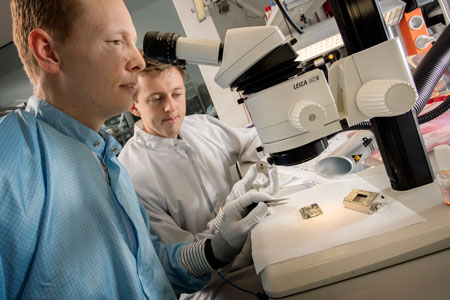Two DTU students are working on developing an instrument for a robot vehicle that is to be sent to Mars as a part of the ‘Mars 2020’ NASA mission.
Is there life on Mars, has there ever been running water on the planet, and how was the solar system created? These are weighty questions that David Arge Klevang Pedersen and Andreas Härstedt Jørgensen, two PhD students at DTU Space, find fascinating.
That is why they jumped at the chance when their supervisor—Professor John Leif Jørgensen, Head of Section for Measurement and Instrumentation at DTU Space—asked if they would be interested in working with NASA on developing an instrument for a robot that will be sent to Mars in 2020.
The objective is to explore the red planet to determine whether it has ever supported life. In addition, NASA will be looking to collect knowledge and demonstrate technologies that may be used for manned Mars expeditions in the future
Equipment must be able to withstand radiation
“The mission is hugely exciting because it has to do with finding answers to a number of absolutely fundamental questions. It’s also fascinating to have the chance to work on equipment that’s going to be sent into space. The requirements are huge, because the equipment has to be able to withstand major temperature fluctuations, as well as radiation from the sun and our cosmic surroundings. The temperature on Mars can actually vary from -128 to +40°C,” relates David Arge Klevang Pedersen.
In 2015, David spent six months at the NASA research centre at Caltech in California, testing the equipment on stones that resemble those on Mars. In December, he and Andreas Härstedt Jørgensen jointly submitted their PhD thesis. The two friends have already presented their initial findings, and are counting on being able to submit their final report to NASA in 2016.
"Our assignment encompasses delivering the camera and developing the part of the instrument that navigates the robot towards the stone. "
Andreas Härstedt Jørgensen, PhD student, DTU Space

The instrument that the students are working to develop in partnership is one of seven selected for installing on the robot vehicle known as the ‘Mars 2020 Rover’. Their instrument is called PIXL and is intended for mounting on the robot’s arm. PIXL consists of a focused X-ray-fluorescing instrument designed to identify the elemental composition of stones at extremely high resolution. It is fitted with a camera which, in combination with structured light, will help navigate the instrument with great accuracy among the rock formations that are to be examined on Mars.
Looking for deposits
The technology functions through PIXL firing thin X-rays at the stones, which fluoresce differently depending on the elements they contain. The camera then takes a digital image that is sent back to NASA, where biologists and geologists examine the composition of the stones in an attempt to find traces of deposits from living biological microcells. The most promising samples will be collected and stored on Mars, ready to be brought back to Earth as part of a subsequent mission.
“Our assignment encompasses delivering the camera and developing the part of the instrument that navigates the robot towards the stone. It entails, for example, establishing the distance between stone and instrument, and triggering a warning if parts of the stone are sticking out, thus constituting a hazard to the instrument itself,” relates Andreas Härstedt Jørgensen.
Has to work every time
The camera on PIXL is a further development of DTU Space’s star camera, which consists of a digital camera that photographs the night sky and a computer that matches the digital pictures against a stellar map stored in the computer.
The star camera is used as a ‘compass’ for the spacecraft, allowing researchers to pinpoint their orientation in space. David Arge Klevang Pedersen relates that the star camera has completed more than 50 international missions, on which it has proved its capacity to handle changing space weather conditions and tough radiation.
“Where other researchers start from scratch when developing new equipment, we are adapting the core of the star camera. This is a huge advantage —especially when working on equipment destined for space travel, where you don’t have the chance to tighten a screw or make tiny adjustments. The challenge of the Mars project is that the technology has to work every time. Otherwise, it could have major consequences for the entire mission,” he concludes.
For additional information, see mars.nasa.gov/mars2020